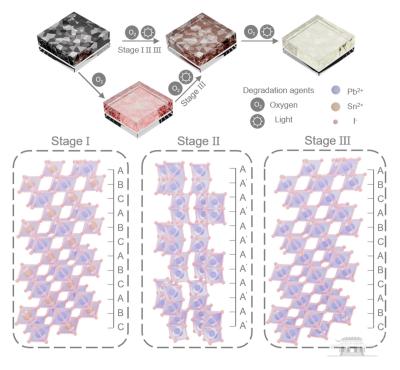Researchers from China's Wuhan University and Hubei University have examined the long-term stability problem of tin-lead perovskites under irradiation, counterintuitively discovering an irreversible phase reconstruction process.
The evolution from tin-lead perovskites to a reconstruction of lead perovskites under light. Image from: Nature Communications
Tin-lead perovskite materials show promise for all-perovskite tandem solar cells, offering an optimal bandgap that significantly boosts power conversion efficiency. However, light-induced degradation, particularly in ambient air, remains a major obstacle to their long-term stability. Unlike single-metal perovskite materials, tin-lead perovskite degrades through distinct mechanisms, making it crucial to understand how it deteriorates under light and air exposure.
Using in-situ photoluminescence spectroscopy, the research team monitored the phase reconstruction of tin-lead perovskite under light exposure. This revealed a process driven by superoxide-induced oxidation of Sn2+ and vacancy formation. This mechanism promotes the transformation between different perovskite phases, ultimately affecting the material's stability. These phenomena were unique to tin-lead perovskite, as no such behavior was observed in pure lead or tin perovskites.
This study provides insights into improving the long-term stability of all-perovskite tandem solar cells, contributing to foundational knowledge that could aid their future commercial application.


